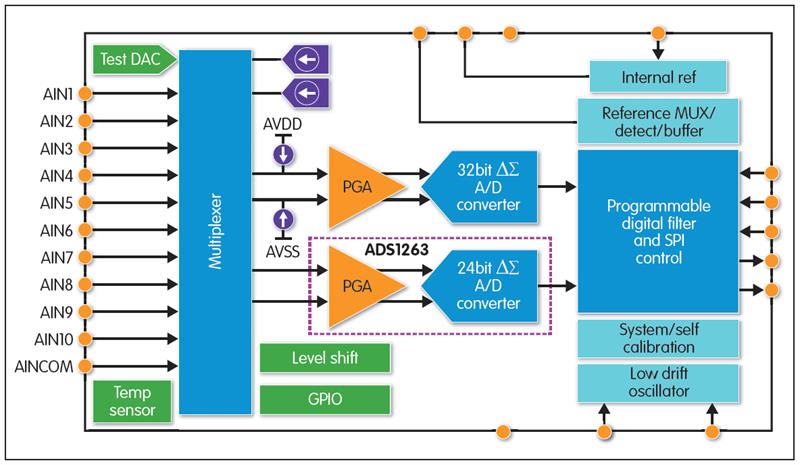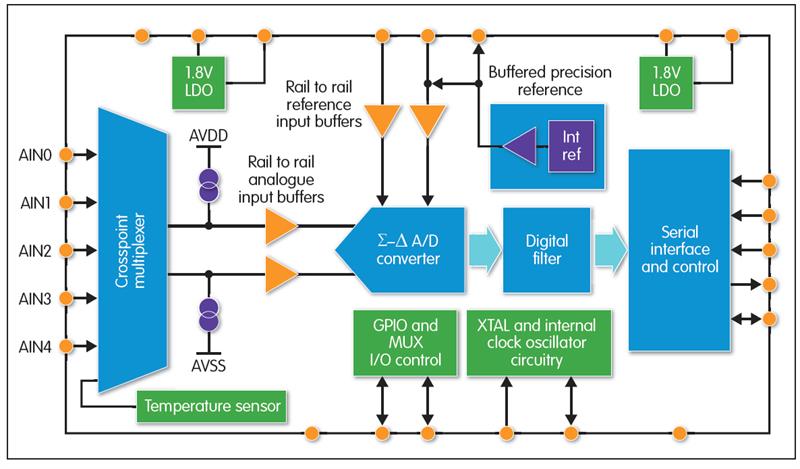While the world of the microcontroller has embraced the concept of 32bit data wholeheartedly, the world of data conversion has not been so fortunate. Although it is theoretically possible to create a 32bit data converter, it hasn't happened because noise rendered the extra resolution unusable.
But two recent developments have taken the world of data conversion into the 32bit domain: Analog Devices has introduced the AD7177-2, while Texas Instruments has just unveiled the ADS1262 and 1263. Both companies have based their products on the sigma-delta approach.
TI says that, previously, those specifying a high resolution A/D converter had to trade-off against noise or low offset drift. The ADS1262 and 1263 are said to eliminate these trade-offs, maximising performance in a range of applications.
Mark Murphy, sigma-delta converter product marketing manager with Analog Devices, said: "Until now, there was no point in building a 32bit converter if the signals were going to be swamped by noise. But we've now got noise to the point where the additional resolution of a 32bit converter can be used by customers. It's been a bit of a balancing act, but we're now at the point where 32bit resolution is achievable."
And Analog Devices and Texas Instruments aren't building 32bit converters because they can, both are responding to industry demand. Bryan Lizon, a product marketer from TI's precision data conversion group, said end users are looking for high accuracy and integration. "High end applications like test and measurement are moving beyond 24bit, so there is a need for better accuracy."
Lizon noted the largest market for the ADS1262 and 1263 is likely to be PLCs. "The previous generation of data converters – the 24bit ADS1255 and 1256 – was designed for programmable logic controllers (PLCs) and a large PLC manufacturer helped us to define these new parts," he added.

| Block diagram of the TI ADS1262/1263 |
Murphy said he sees demand for 32bit converters being pushed by the instrumentation sector. "It's those with demanding sensor applications," he continued, "including analytical instruments and medical devices. But we also see demand from high accuracy PLC applications and from the seismic world. In all of these applications, customers are looking to resolve smaller signals."
Lizon said there are three main reasons for interest in 32bit converters such as the ADS1262/3. "Apart from the need for an effective number of bits (ENOB) of more than 24, we also see a requirement for greater system reliability and lower offset drift. Industry 4.0, in general, needs greater reliability and it's not just the system; it means every part in the system. Integrated monitoring and diagnostic features support internal and external fault detection. Meanwhile, offset error drift is 80% lower than competitive solutions."
The ADS1262 and ADS1263 are low noise, low drift delta-sigma A/D converters running at up to 38.4ksample/s. They feature an integrated PGA with a gain from 1 to 32, reference and internal fault monitors. The ADS1263 also features an auxiliary 24bit delta-sigma A/D converter intended for background measurements. "You can also use the 24bit A/D for diagnostics," Lizon pointed out, "or use it for cold junction temperature compensation."
According to Analog Devices, the AD7177-2 integrates key analogue and digital signal conditioning blocks to allow users to configure an individual setup for each analogue input channel in use.
It notes that integrated true rail to rail buffers on the analogue and external reference inputs provide easy to drive high impedance inputs, while a precision 2.5V low drift bandgap internal reference adds embedded functionality to reduce external component count.

| Block diagram of Analog Devices' AD7177-2 |
Why have both companies selected the sigma-delta architecture for these parts? "It's because of the noise," Lizon noted. "You can't get the low noise performance or the signal to noise ratio you need from something like an SAR architecture. Sigma-delta is geared towards dealing with slow moving signals and I think it shines in the applications at which we're targeting the ADS1262/3."
Analog Devices design engineer Adrian Sherry pointed out: "The classical application for an SAR converter is single sample, single result. You won't get SAR to 32bit resolution. You could oversample to get higher resolution out of SAR, but sigma-delta is naturally oversampled."
As both companies point out, noise is the issue when you get to 32bit resolution and both are keen to highlight the low noise levels of their respective parts. In TI's case, the ADS1262/3 generates just 7nV rms at 2.5sample/s. From the device's datasheet, when running at 2.5sample/s in Sinc4 filter mode, users can expect an ENOB of 26.9, with 25.0 noise free bits.
Sherry said the number of noise free bits available from the converter was dominated by peak to peak noise. "The 7177-2 can have more than 24 noise free bits at lower data rates." From the device's datasheet, a noise of 7nV rms is claimed at 5sample/s, with an effective resolution of 26.7bit.
Lizon also highlighted noise performance. "From an AC perspective," he claimed, "the ADC1 input of the ADS1262 and the ADS1263 supports a noise floor of more than 100dB to 19kHz, and more than 120dB to 8kHz, with these measurements taken with respect to the converter's full scale input.
"From a DC perspective," he continued, "the analogue inputs of the converters support an ENOB/input referred noise of more than 20bit for virtually all data rate, gain and filter order combinations."
So is the performance available from both companies' 32bit A/D converters achieved through design expertise, process technology or a combination of both? Sherry said it was a mixture of both. "Finer CMOS processes allow more digital content to be integrated onto the device and that means more opportunity to correct imperfections, but the process needs to be linear otherwise the benefits won't be translated into resolution and bits.
"A process that can support a wider supply range is always important because you will get more noise free bits. Meanwhile, analogue design techniques are always critical, particularly when it comes to power efficiency, and there are always 'tweaks' being made."
Lizon said the ADS1262/3 used the same process as the previous generation of converters. "I see this as more of a design challenge," he said. "It's about integrating more features, such as monitoring and diagnostics; features that weren't found in the previous generation."
Sherry said the AD7177-2 used a similar core to the 24bit AD7175. "We have provided the extra resolution primarily by using digital assistance and filtering."
In Murphy's opinion, one of the larger design challenges was the front end. "We wanted to make it easier to drive the converter at the sampling rate." Sherry added that the 7177-2's rail to rail buffers made that task easier.
Both companies realise that offering a component is only half of the job today; a range of support is available online, including reference designs and IBIS models. TI, meanwhile, has recently set up the Data Converter Learning Centre online, allowing visitors to access technical articles andvideos blogs.
"It's about solutions," Murphy concluded, "not components. We live or die by what we offer and components alone don't cut it any more – customers want solutions."













